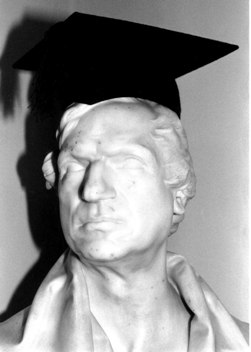Geologist and science writer Nina Morgan* asks - what’s in a name?
 The type localities for the Cambrian, Ordovician and Silurian Systems are all located in Wales – but the exact sites where they were first defined are not always easy to pinpoint. This is not necessarily because they are hard to reach geographically – the site where Roderick Murchison ‘discovered’ the Silurian is located just alongside the A470, south of Builth – but because for non-native speakers, the Welsh language, and particularly the spelling, can be very hard to grasp. The early 19th Century English-speaking surveyors working for the Ordnance Survey relied on noting down place names as they heard them spoken aloud by locals – and introduced some very creative spellings as a result.
The type localities for the Cambrian, Ordovician and Silurian Systems are all located in Wales – but the exact sites where they were first defined are not always easy to pinpoint. This is not necessarily because they are hard to reach geographically – the site where Roderick Murchison ‘discovered’ the Silurian is located just alongside the A470, south of Builth – but because for non-native speakers, the Welsh language, and particularly the spelling, can be very hard to grasp. The early 19th Century English-speaking surveyors working for the Ordnance Survey relied on noting down place names as they heard them spoken aloud by locals – and introduced some very creative spellings as a result.
While working in Wales, Murchison, it seems, adopted a similar approach and achieved similar results. In 1831 Murchison identified ‘the first true Silurian’ rocks at a place in the Wye Valley he referred to as ‘Cavansham Ferry’ – a name that isn’t recognised locally, and doesn’t appear on any map. The exact site of Murchison’s discovery remained a mystery in until the 1990s, when a combination of very detailed field and linguistic work enabled it to be located.
In contrast, the Reverend Adam Sedgwick (pictured), who also worked in Wales, appeared to take the Welsh language in his stride. Although born in Yorkshire, he represented himself as somewhat of an expert in Welsh pronunciation. In a letter dated ‘Tremadoc, July 23rd 1846’, he instructed his niece Fanny Hicks how it should be done:
“….The miserable damp weather made me rheumatic and low-spirited, so I nursed one day in Carnarvon and then drove to Pwllheli. What a charming name! In order to pronounce the first part (Pwll), you must blow out you cheeks just as you do when puffing at a very obstinate candle; then you rapidly and cunningly put your tongue to the roof of your mouth behind the fore teeth, and blow hard between your cheeks and your tongue, holding your tongue quite steady all the while, as a man does a spade just before he is going to give it a good thrust with his right foot. With such a beautiful direction you cannot fail to pronounce Pwll quite like a Celt. Should the word be Bwlch, take care to observe the previous direction, only, in addition while the wind is whistling between your rigid tongue (sticking forwards spade-fashion), and your distended cheeks, contrive by way of a finale to give a noise with your throat such as you make when an intrusive fishbone is sticking in it. So much for my first Welsh lesson… If you write by return of post you may address me at Dolgelly, North Wales. “
But even Sedgwick had some trouble with Welsh spelling. The correct English spelling of Tremadoc – different Welsh spellings are often used in Wales these days -- is Tremadog, and Carnarvon translates as Caernarvon (Caernarfon, if you’re Welsh). And Sedgwick’s ‘Doglelly’ is more commonly referred to as Dolgellau. A case of the pot calling the kettle black? Or proof that when working in Wales annigonol ydy un iaith (one language is never enough). Pob lwc! [good luck!].
§ ‘Lost in translation’, somewhat awkwardly rendered into the Language of Heaven, but with less loss than Google translate, which suggests ‘ar goll yn cyfieithu’ or ‘lost translating’. Golygydd.
Acknowledgment
Thanks to Duncan Hawley for drawing my attention to Sedgwick’s letter on Welsh pronunciation, showing me around Murchison’s field area in the Wye Valley and discussing the methods he used to locate the site where Murchison discovered the Silurian.
The location of the key Murchison Silurian site is described in: Hawley, Duncan, 1997, The first true Silurian: an evaluation of the site of Murchison’s discovery of the Silurian, Proceedings of the Geologists Association, vol 108, pp. 131-140. Sedgwick’s letter is reprinted in: Clark & Hughes, ‘The Life and Letters of the Reverend Adam Sedgwick’ vol. 2, pp. 105-106. The difficulties of recording Welsh place names in the 19th century are discussed on pp. 191-194 of the book, Map of a Nation by Rachel Hewitt. An Ordnance Survey guide, Introduction to the Welsh origins of place names in Britain is available at www.ordnancesurvey.co.uk/oswebsite/freefun/didyouknow/placenames/welshglossary-a-b.html.
-
If the past is the key to your present interests, why not join the History of Geology Group (HOGG)? For more information and to read the latest HOGG newsletter, visit: www.geolsoc.org.uk/hogg, where theprogramme and abstracts from the Conference on Geological Collectors and Collecting are available as a pdf file free to download.
*Nina Morgan is a geologist and science writer based near Oxford.